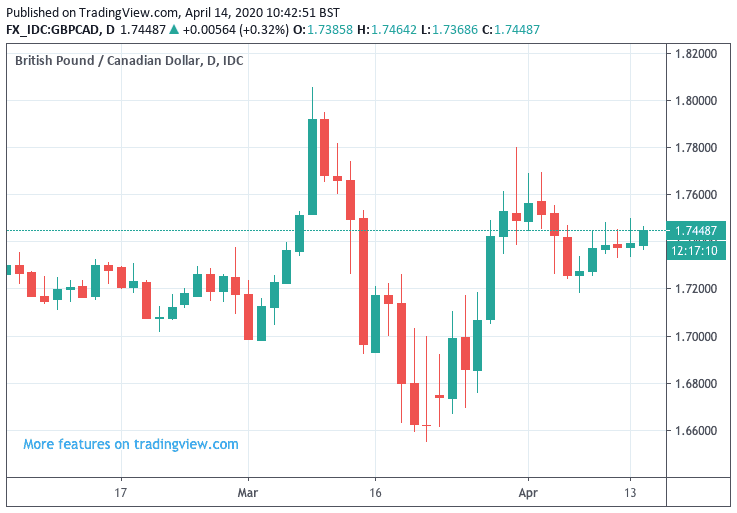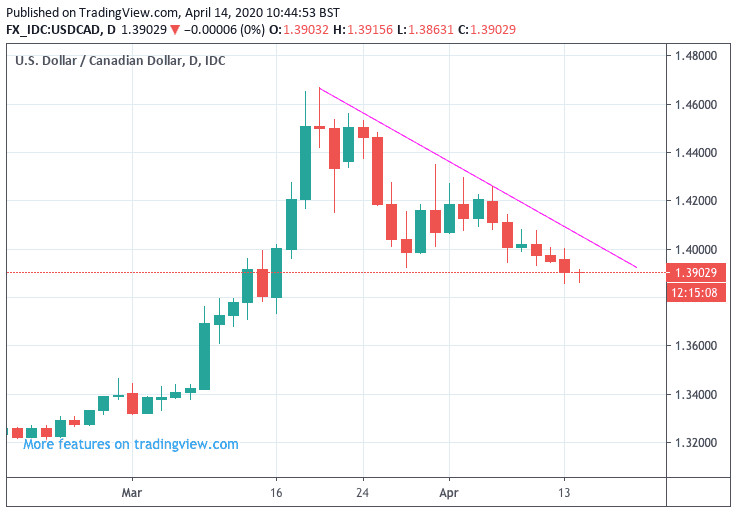Pound a "Buy on Dips" against Canadian Dollar says Analyst as OPEC+ Deal Weighs
- OPEC+ cuts fail to lift CAD
- GBP/CAD choppy, but biased for gains
- USD/CAD moves almost purely a function of USD weakness

Image © Adobe Stock
- GBP/CAD market rate at time of publication: 1.7460
- Bank transfer rates (indicative): 1.6849-1.6971
- FX specialist rates (indicative): 1.7068-1.7303 >> More information
The Canadian Dollar's ascent against the U.S. Dollar remains intact owing to a broad-based retracement of the Greenback in line with improving global investor sentiment built on the assumption that the worst of the coronacrisis is now behind us, however against Pound Sterling the Canadian unit remains directionless.
Canadian Dollar appreciation against the U.S. Dollar is therefore certainly more of a function of Dollar weakness than any genuine Canadian Dollar strength, as we would expect to see the Canadian currency outperforming on other crosses if there were any compelling reasons to buy it.
Capping the Canadian Dollar's upside potential will be developments in oil markets, where agreements to cut production at the OPEC+ meeting last week failed to generate any material upside in oil prices.
Oil is a major foreign currency earner for Canada and it is therefore a fundamental pillar to CAD valuations. Without upside traction in the global oil benchmarks we would expect the country's foreign exchange earning potential to remain relatively limited, which should keep a lid on any Canadian Dollar exuberance against a host of currencies.
"CAD softness reflects the market’s dissatisfaction with the “historic” oil production cuts agreed by OPEC+ last week and its lack of impact on WTI (as large as the cuts are, they do not perhaps fully offset the demand destruction resulting from global slowdown)," says Shaun Osborne, Chief FX Strategist at Scotiabank.
The Pound-to-Canadian Dollar exchange rate is quoted at 1.7448, up from last week's low at 1.7184 but down from the April 01 high at 1.7688.
Above: GBP/CAD daily chart.
"GBP/CAD remains range bound but looks slightly better bid above the 40-day MA (1.7240) which held last week’s dip in the GBP. Trend strength signals are tilting a little more GBP supportive now," says Osborne. "We continue to think the GBP is a buy on dips."
The U.S. Dollar-to-Canadian Dollar exchange rate is meanwhile quoted at 1.3909, which puts it in line with a broad decline that has been in place since 1.4668 on March 19.
Above: USD/CAD daily chart
Despite the USD's descent against its northern neighbour, the move could be in danger of fading.
"USD/CAD retains a soft undertone and shorter term trend signals are aligned bearishly, if weakly, for USDCAD. The run lower in funds may be running near to its full course for now, however," says Osborne, "the USD is moving deeper into oversold territory.
The OPEC+ deal saw OPEC and Russia agree to cut production by 9.7 million barrels per day over the course of the next two months, which represents the largest margin ever agreed by OPEC.
Yet, oil prices hardly reacted and are in fact down on Tuesday as the actions simply won't make up for the global slump in demand. It is estimated that global demand has fallen in excess of 30 million barrels per day in the second quarter as the world's largest economies shut down to try and stem the spread of the coronavirus.
"With Europe returning from holiday, we keep a close eye on the broad USD and commodity currencies post-OPEC++ deal. While the latter delivered cuts, it still falls short of the demand destruction expected near-term," says Mark McCormick Global Head of FX Strategy at TD Securities.
The OPEC+ deal remains in place until April 2022, with the quotas increasing by 2 million barrels per day in the second half of 2020, and then another 2 million barrels per day up to April 2022.
The reference point for the cuts was production in October 2018 for most, although both Russia and Saudi agreed to a baseline of 11 million barrels per day.
A significant problem facing oil producers is that simply cutting supply is not as easy as simply turning off a tap as most oil fields and supply lines are designed to keep pumping, which draws question marks on how achievable the agreements inked on paper really are.
For example, while Russia has committed to a 2.5 million barrel per day cut, analysts suggest this is more than 10x its agreed cut under the last OPEC+ deal.
"The demand drop for oil as countries have locked down activity has been unprecedented, with demand in April expected to be down more than 20mb/d. Huge uncertainty remains about the duration of the lockdowns and hence the timing of a demand recovery. In April alone, global inventories could grow by 600m barrels; if there is not a sharp improvement in demand in May then global storage infrastructure risks being overwhelmed, even with the OPEC+ cut," says Henry Tarr, Analyst at Berenberg Bank.
Berenberg's models anticipate a price of USD30/bbl and while the OPEC+ agreement poses a sizeable burden on oil producers Tarr says the moves nevertheless potentially set the stage for a bottoming of crude and a recovery looking into the second half of 2020 and 2021.
Berenberg still expect 2021 oil prices to average above USD50/bbl.
If the Canadian Dollar is to follow the fortunes of crude oil prices, we could therefore be due to see suppressed CAD valuations for the short- and medium-term.











